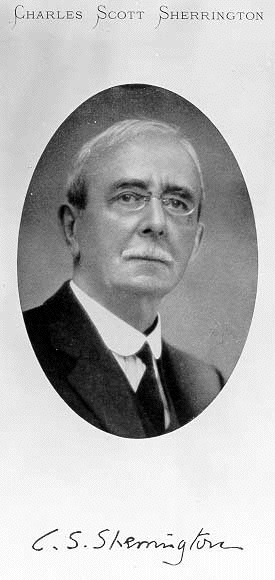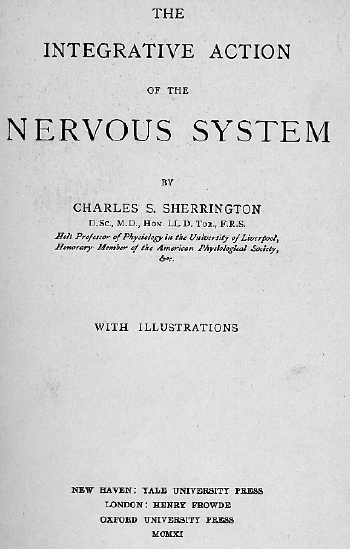 - Quotation
-
- «The synaptic
nervous system has developped as its distinctive
feature a central organ, a so-called central
nervous system; it is through this that it
brings into rapport one with another widely
distant organs of the body, including the
various portions of the diffuse nervous sytem
itself». page 312
-
- «To move things is
all mankind can do... whether whispering, or
felling a forest» the motor system is the
only avaiblae external outpout channel of the
brain...
-
-

-
- Yale University Press, New Haven 1911, first
American edition, second printing (first was
published in 1906). Cloth hard covers, 8vo,
xviii + 411pp, 85 text figures. "Sherrington's
Silliman Lectures at Yale stand as the true
foundation of modern physiology; it is
considered by Fulton to rank in importance with
Harvey's De Motu Cordis, while Walshe asserts
that it holds a position in physiology similar
to Newton's Principia in physics." His work on
the nervous system, especially his experimental
studies on reflex action, has had a profound
influence upon modern physiology.
- Sherrington
was a co-winner of the 1932 Nobel Prize in
Physiology and Medicine for his discoveries
regarding the functions of neurons.
-
- "Charles Scott Sherrington was born on
November 27, 1857, at Islington, London. In 1876
Sherrington began medical studies at St.
Thomas's Hospital and in 1878 passed the primary
examination of the Royal College of Surgeons,
and a year later the primary examination for the
Fellowship of that College. After a short stay
at Edinburgh he went, in 1879, to Cambridge as a
noncollegiate student studying physiology under
Michael Foster, and in 1880 entered Gonville and
Caius College there.
-
- In 1881 he attended a medical congress in
London at which Sir Michael Foster discussed the
work of Sir Charles Bell and others on the
experimental study of the functions of nerves
that was then being done in England and
elsewhere in Europe. At this congress
controversy arose about the effects of excisions
of parts of the cortex of the brains of dogs and
monkeys done by Ferrier and Goltz of Strasbourg.
Subsequently, Sherrington worked on this problem
in Cambridge with Langley, and with him
published, in 1884, a paper on it. In this
manner Sherrington was introduced to the
neurological work to which he afterwards devoted
his life.
-
- The years 1884 and 1885 were eventful ones
for Sherrington, for during the winter of
1884-1885 he worked with Goltz at Strasbourg, in
1884 he obtained his M.R.C.S., and in 1885 a
First Class in the Natural Sciences Tripos at
Cambridge with distinction. During this year he
published a paper of his own on the subject of
Goltz's dogs. In 1885 he also took his M.B.
degree at Cambridge and in 1886 his
L.R.C.P.
-
- In 1885 Sherrington went, as a member of a
Committee of the Association for Research in
Medicine, to Spain to study an outbreak of
cholera, and in 1886 he visited the Venice
district also to investigate the same disease,
the material then obtained being examined in
Berlin under the supervision of Virchow, who
later sent Sherrington to Robert Koch for a six
weeks' course in technique. Sherrington stayed
with Koch to do research in bacteriology for a
year, and in 1887 he was appointed Lecturer in
Systematic Physiology at St. Thomas's Hospital,
London, and also was elected a Fellow of
Gonville and Caius College, Cambridge. In 1891
he was appointed in succession to Sir Victor
Horsley, Professor and Superintendent of the
Brown Institute for Advanced Physiological and
Pathological Research in London. In 1895 he
became Professor of Physiology at the University
of Liverpool.
-
- During his earlier years in Cambridge,
Sherrington, influenced by W. H. Gaskell and by
the Spanish neurologist, Ramón y Cajal,
whom he had met during his visit to Spain, took
up the study of the spinal cord. By 1891 his
mind had turned to the problems of spinal
reflexes, which were being much discussed at
that time, and Sherrington published several
papers on this subject and, during 1892-1894,
others on the efferent nerve supply of muscles.
Later, from 1893-1897, he studied the
distribution of the segmented skin fields, and
made the important discovery that about
one-third of the nerve fibres in a nerve
supplying a muscle are efferent, the remainder
being motor.
-
- In 1906 he published his well-known book:
The Integrative Action of the Nervous System,
being his Silliman Lectures held at Yale
University the previous year, and in 1913 he was
invited to become Waynfleet Professor of
Physiology at Oxford, a post for which he had
unsuccessfully applied in 1895, and here he
remained until his retirement in 1936. Here he
wrote, and published in 1919, his classic book
entitled Mammalian Physiology: a Course of
Practical Exercises, and here he regularly
taught the students for whom this book was
written……
-
- The philosopher in him ultimately found
expression in his great book, Man on his Nature,
which was the published title of the Gifford
Lectures for 1937-1938, which Sherrington gave.
As is well known, this book, published in 1940,
centres round the life and views of the 16th
century French physician Jean Fernel and round
Sherrington's own views. In 1946 Sherrington
published another volume entitled The Endeavour
of Jean Fernel.
-
- Sherrington was elected a Fellow of the
Royal Society of London in 1893, where he gave
the Croonian Lecture in 1897, and was awarded
the Royal Medal in 1905 and the Copley Medal in
1927. In 1922 the Knight Grand Cross of the
Order of the British Empire and in 1924 the
Order of Merit were conferred upon him. He held
honorary doctorates of the Universities of
Oxford, London, Sheffield, Birmingham,
Manchester, Liverpool, Wales, Edinburgh,
Glasgow, Paris, Strasbourg, Louvain, Uppsala,
Lyons, Budapest, Athens, Brussels, Berne,
Toronto, Montreal, and Harvard………
he died in 1952." (Website
of the Nobel Foundation; winner 1932)
-
-
- Sherrington's law = The law of reciprocal
innervation: when one set of muscles is
stimulated, muscles working against the activity
of the first will be inhibited.
-
- Sir Charles Scott Sherrington's research,
spanning more than 50 years, laid the
foundations for modern neurophysiology. He
maintained that the most important function of
the nervous system in higher animals is the
coordination of the various parts of the
organism. Although best known for his long
series of studies on spinal reflexes, he made
equally great strides in the physiology of
perception, reaction, and behaviour. He was the
first to adequately study the synapse and
originated the term. He also introduced the term
exterioceptor, proprioceptor and viscerocepter.
In 1932 he shared the Nobel Prise in Physiology
or Medicine with Edgar Douglas Adrian.
-
- Sherrington was the son of Anne Brookes and
James Norton Sherrington, of Caister, Great
Yarmouth, a country physician who died when he
was quite young. His mother married Caleb Rose,
Jr., of Ipswich, a physician of wide cultural
interests and a noted archaeologist. The Rose
home, a gathering place for artists and
scholars, helped to shape Sherrington's broad
interest in science, philosophy, history, and
poetry. One of his schoolmasters, Thomas Ashe,
was a poet of considerable distinction.
-
- After attending the Ipswich Grammar School
from 1870 to 1875, Sherrington, encouraged by
his stepfather, began medical training at St.
Thomas's Hospital in London. He passed the
primary examination of the Royal College of
Surgeons in 1878, and a year later the primary
examination for the Fellowship of that
College.
-
- In 1879 he went to Cambridge as a
noncollegiate student studying physiology under
the "father of British physiology", Sir Michael
Foster (1836-1907), and in 1880 entered Gonville
and Caius College there. During the years
1881-1885 he worked chiefly under two of
Forster's pupils who were already becoming world
famous Ð John Newport Langley (1852-1925)
and Walter Gaskell (1847-1914). Langley and
Gaskell imparted to him their dominant interest
in how anatomical structure reflects, or is
expressed in, physiological function.
-
- In 1881 he attended a medical congress in
London at which Sir Michael Foster discussed the
work of Sir Charles Bell and others on the
experimental study of the functions of nerves
that was then being done in England and
elsewhere in Europe. At this congress
controversy arose about the effects of excisions
of parts of the cortex of the brains of dogs and
monkeys done by David Ferrier (1843-1928) and
Friedrich Leopold Goltz (1834-1902) of
Strasbourg. Subsequently, Sherrington worked on
this problem in Cambridge with Langley, and with
him published, in 1884, a paper on it. In this
manner Sherrington was introduced to the
neurological work to which he afterwards devoted
his life.
-
- In 1883 Sherrington became Demonstrator of
Anatomy at Cambridge under Professor Sir George
Humphrey, and during the winter session of
1883-1884 at St. Thomas's Hospital he
demonstrated histology.
-
- From 1884 to 1887 Sherrington completed his
medical courses. After graduation he worked with
Langley, studying the anatomical changes in the
cord and brain stem of decorticate dogs which
had first been exhibited by Friedrich Goltz at
the International Congress in 1881. This led to
the first of many visits to Goltz' laboratory in
Strassburg.
-
- Between 1884 and 1887 he turned his
attention to bacteriology. In 1885 Sherrington
went, as a member of a Committee of the
Association for Research in Medicine, to Spain
to study an outbreak of cholera, and in 1886 he
visited the Venice district also to investigate
the same disease. In Spain he met Santiago
Ramón y Cajal (1852-1934) and later
persuaded him to lecture in England. He also
went to Berlin to have the cholera material
examined under the supervision of Rudolf Virchow
(1821-1902), who later sent Sherrington to
Robert Koch (1843-1910) for a six weeks' course
in technique. Sherrington stayed with Koch to do
research in bacteriology for a year. Thus he
gained a superb grounding in physiology,
morphology, histology, and pathology.
-
- He obtained his M.R.C.S. in 1884 and in 1885
a First Class in the Natural Sciences Tripos at
Cambridge with distinction. During this year he
published a paper of his own on the subject of
Goltz's dogs. In 1885 he also took his M.B.
degree at Cambridge and in 1886 became a
Licentiate of the Royal College of
Physicians.
-
- In 1887 Sherrington was appointed lecturer
in physiology at St. Thomas's medical school in
London, where he continued to investigate the
spinal tract. From 1891 to 1905 he served as
physician-superintendent of the Brown
Institution, a centre for human and animal
physiological and pathological research,
succeeding Sir Victor Alexander Haden Horsley
(1857-1916). Here he was able to observe animals
with chronic spinal lesions.
-
- In 1895 Sherrington was appointed Holt
Professor of physiology in Liverpool, where he
did much of his best work. From 1913 until his
retirement in 1935 he held Waynflete chair of
physiology at Oxford, succeeding Francis Gotch
(1853-1913).
|



